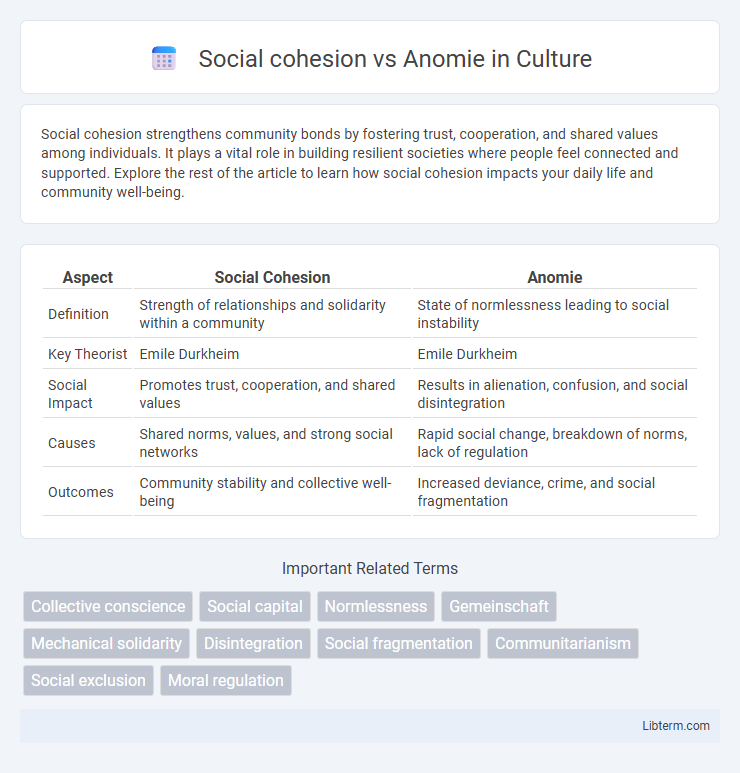Social cohesion strengthens community bonds by fostering trust, cooperation, and shared values among individuals. It plays a vital role in building resilient societies where people feel connected and supported. Explore the rest of the article to learn how social cohesion impacts your daily life and community well-being.
Table of Comparison
| Aspect | Social Cohesion | Anomie |
|---|---|---|
| Definition | Strength of relationships and solidarity within a community | State of normlessness leading to social instability |
| Key Theorist | Emile Durkheim | Emile Durkheim |
| Social Impact | Promotes trust, cooperation, and shared values | Results in alienation, confusion, and social disintegration |
| Causes | Shared norms, values, and strong social networks | Rapid social change, breakdown of norms, lack of regulation |
| Outcomes | Community stability and collective well-being | Increased deviance, crime, and social fragmentation |
Understanding Social Cohesion: Definition and Key Elements
Social cohesion refers to the strength of relationships and the sense of solidarity among members of a community, characterized by shared values, trust, and mutual support. Key elements include social inclusion, social capital, and a collective identity that fosters cooperation and resilience within society. Understanding these components helps distinguish social cohesion from anomie, which denotes social instability and normlessness resulting from weak social bonds.
The Concept of Anomie: Origins and Evolution
The concept of anomie, originally developed by Emile Durkheim, describes a state of normlessness where social norms become unclear or break down, leading to social instability and individual alienation. This condition arises during periods of rapid social change or crisis when traditional norms fail to regulate behavior effectively. Over time, the understanding of anomie has evolved to encompass various forms of social disintegration, contrasting sharply with the idea of social cohesion, which emphasizes the strength of social bonds and collective regulation.
Social Cohesion vs Anomie: Core Differences
Social cohesion refers to the strength of relationships and the sense of solidarity among members of a community, fostering cooperation and social integration. Anomie, a concept introduced by sociologist Emile Durkheim, describes a state of normlessness or social instability resulting from a breakdown in social bonds and shared values. The core difference lies in social cohesion promoting collective unity and stability, while anomie signifies societal fragmentation and the erosion of common norms.
The Role of Community in Fostering Social Cohesion
Community plays a critical role in fostering social cohesion by promoting shared values, mutual trust, and collective identity, which counteracts feelings of anomie--a state of normlessness and social instability. Strong social networks within communities enhance cooperation and support systems, reinforcing social bonds and reducing alienation among individuals. Through communal activities, inclusive institutions, and active civic engagement, communities create environments where individuals feel connected and valued, which strengthens social order and mitigates the risks of social fragmentation.
Factors Leading to Anomie in Modern Societies
Rapid urbanization, economic inequality, and cultural fragmentation contribute significantly to anomie in modern societies by undermining social cohesion and shared norms. Technological advancements and globalization accelerate changes in values and roles, creating confusion and normlessness among individuals. Weak social institutions and declining community engagement further exacerbate feelings of isolation and disconnection, intensifying anomie.
Social Institutions: Strengthening Cohesion or Fueling Anomie?
Social institutions such as family, education, and religion play a critical role in strengthening social cohesion by promoting shared values, norms, and collective identity. Conversely, when these institutions weaken or fail to address social inequalities, they can contribute to anomie, characterized by a breakdown of social norms and a sense of alienation among individuals. Effective social institutions thus either reinforce societal bonds essential for stability or exacerbate social disintegration leading to increased anomie.
Impacts of Social Cohesion on Individual Well-being
High social cohesion fosters a sense of belonging, reduces feelings of isolation, and supports mental health by providing individuals with social support networks. Communities with strong social bonds exhibit lower levels of stress, depression, and anxiety, contributing to improved overall well-being. Enhanced social cohesion also promotes resilience, enabling individuals to better cope with adversity and life challenges.
Consequences of Anomie: Social Disorder and Alienation
Anomie results in weakened social cohesion, leading to increased social disorder as individuals feel disconnected from societal norms and values. This breakdown fosters alienation, causing people to experience isolation and a lack of purpose within their community. The consequences include higher crime rates, reduced trust among citizens, and diminished community engagement.
Strategies to Enhance Social Cohesion and Prevent Anomie
Promoting social cohesion requires implementing community engagement programs, fostering inclusive education, and encouraging participatory governance to build trust and shared values among diverse groups. Strengthening social networks and support systems mitigates feelings of isolation, directly counteracting the emergence of anomie by providing individuals with a sense of belonging and purpose. Policymakers should focus on economic equity and access to resources to address structural causes of social disintegration, enhancing overall societal stability and integration.
Case Studies: Examples of Cohesive and Anomic Societies
Case studies illustrate that Scandinavian countries like Norway and Sweden exhibit high social cohesion, characterized by strong welfare systems, low crime rates, and robust trust in institutions, fostering societal stability. In contrast, societies experiencing anomie, such as post-Soviet Russia during the 1990s, faced disintegration of social norms, leading to increased crime, political instability, and economic uncertainty. Comparative analysis highlights how cohesive societies benefit from shared values and social integration, while anomic environments suffer from normlessness and social fragmentation.
Social cohesion Infographic

 libterm.com
libterm.com